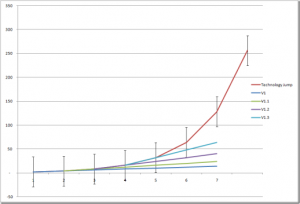What it means is something that developers are very familiar with and that most other people generally don’t want to hear.
It means that there are a range of issues that businesses need to face in the light of this growth. Primarily, your business plans, goals, budgets and thinking need to take into account the mid-term reality of change, not just the perception that it is wise to employ short-term conservation.
For the individual it means the job you did yesterday will change in the way you do it and potentially the role you play, this if you are active in learning is a huge advantage.
Previously we have looked at what the technology spike is and the key trap it creates for all of us.
Continually Evolve
The traditional manufacturing model was to invest in Research & Development (R&D) early on and then develop a manufacturing base to turn out units for years on end. The spike breaks this model.
Most businesses want to see a return on investment for at least 7 to 10 years but with information technology, that is not a viable solution. A technology solution does not improve on its own, so as you stop investing in it, it degrades – it degrades in its usefulness and in data that is no longer fit-for-purpose.
Incremental Improvements
 This graph shows the climb of surrounding technologies after a system is implemented in the first year and how each version falls behind, quickly creating a wider and wider gulf.
This graph shows the climb of surrounding technologies after a system is implemented in the first year and how each version falls behind, quickly creating a wider and wider gulf.
Stepping up new versions, evolving as we describe, keeps you within sight for several more years BUT there comes a point (usually around the 6 to 8-year mark) where updates to the same base technology cannot keep you on track for much longer.
It is BEFORE this point that you need to decide to start again with something to hold you for the next 6 to 8 years.
Stagnating on a single point will see you left behind, far too quickly, as you try to make up for the ground lost through all the previous steps. What tends to happen, though, and all too frequently is the classic statement or thought, “It is too expensive to make those changes now,” and, as a result, the technology dies with that statement.
Don’t Listen to Accountants for Long-term Stability
Gone are the days of 30 years spent doing the same thing and hoping you are on the right track.
Business operators, politicians and “the holder of the purse strings” look at the world from year to year (or maybe a few years ahead of the game). They are driven by a “minimum budget” goal because that, in the short term, means higher profits today.
But, as you see from the previous graphs, this means that they are blinded to the growth potential, and more over, the extreme threat posed by stagnating in the face of that growth curve.
They will try and cut back on investing in new technologies and cut back in investing in evolving existing technologies, and in any 1 to 2 year period, it becomes obvious (in the graph) to see why. There isn’t much obvious change, but then what happens?
The curve starts to move and you’re stuck back in a timeframe 3 to 6 years before and you need to jump all those years at once just to keep up, let alone get ahead.
Watch for Key Jumps
Throughout these 7 to 10-year cycles, there are points where key technology vendors like Microsoft, Apple, etc., release key new technology jumps rather than just the incremental improvements.
Being able to discover, recognise and evaluate the appropriateness of these key jumps is a critical part of being able to keep up in the longer term.
By the time these technologies are main stream, there has been traditionally a 3 to 6 year lag, which (as we have seen in the graphs) is a little too late to be fixing and adapting a near-obsolete technology into something suitable.
As you rely more on IT for your business, these points will become more and more critical to know, absorb and adapt to.
Following these key jumps within the first few years represents a massive competitive advantage right now but, in years to come, as everyone gets used to the curve, it will simply be “the norm”.






